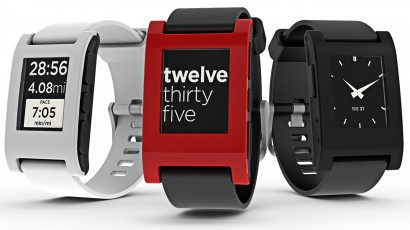
The Watch Snob Takes On Smart Watches

Pebble
“Everyone’s definition of ‘vintage’ is different, but the only one that matters, with respect to timepieces, of course, is mine.“
What Makes Vintage Vintage?
How old does a watch need to be to be considered vintage? I was recently in a respected watch shop and they were selling circa 1990s and 1980s Rolex timepieces as “vintage.” To me, there is something off about that. When I hear “vintage,” I think of something with history, class, dignity and timelessness. I could see how that describes a ’60s-era Rolex, but not an ’80s-’90s version. What are your thoughts?
It is a little disconcerting to those of us of a certain age to see styles, movies, fashions and music from our youth being revived or remade as some sort of retro homage. Everyone’s definition of “vintage” is different, but the only one that matters, with respect to timepieces, of course, is mine. With Rolexes, there are three easily spotted identifiers that place a particular timepiece in the vintage category.
The first is the crystal. With most of its watches, at least the ones anyone cares about, Rolex went directly from using acrylic crystals to sapphire. This happened during the mid- to late-1980s, with most of its watch families. While sapphire has its advantages, if it’s on a Rolex, it’s not vintage. At least not in 2013.
The second characteristic of a vintage Rolex is its luminescent paint. Tritium was used for decades for dial markers before it was replaced in favour of Luminova, which doesn’t crack, discolour or lose its glow. Again, a step forward in technology means a less desirable watch to collectors.
The third identifier is also related to the dial markers. With most vintage Rolexes, the markers were painted directly onto the dial. At some point, again in the 1980s, The Crown decided to surround the markers with white gold borders to prevent flaking. By now, you should see what this means.
Of course, this is Rolex, and nothing is simple, especially when it comes to vintage. So there are so-called “transitional” watches that combine some of the elements above — watches with sapphire crystals but tritium dials, or white gold markers filled with tritium. You’ll need to make up your own mind about how much of a purist you want to be with your vintage watch. Of course, the Rolexes of today will be tomorrow’s vintage, so check back with me in 20 years if I’m unfortunate enough to still be writing this column. On second thought, don’t.
Any other Omega
I thoroughly enjoy reading your column, which I find remarkably self-deprecating (as a reflection upon myself, that is) given my current state of horological knowledge. Here’s my specific question: Why is the only Omega to buy the Speedmaster Pro? Although not much less expensive, I like the look of the Speedmaster Date a bit better (but not the look a true watch fan would give me for wearing it). Is there something about its case or mechanism that’s not up to par? Has it come off the assembly line without the handmade attention of its bigger brother?
Omega painted itself in a corner with the Speedmaster. It created its most iconic and arguably best watch in 1957 and hasn’t really changed it since, and that’s a good thing. Meanwhile, it has churned out hundreds of versions of its other watches, most forgettable fads. The brand had its high point in the 1960s and, really, any of its watches from that era would be fantastic today, if they had been left unchanged.
Omega should have taken a page from Rolex and frozen its designs in time in 1967. Instead they’re still riding the wave of glory from the moon landing that is quickly becoming ancient history. But even without its space connection, the Speedmaster is Omega’s most honest watch, with the most undiluted DNA from its best years. While it is focusing on coaxial this and LiquidMetal that, the Omega everyone wants is the one that’s the same as it was 40 years ago. There’s something to be said for keeping things simple. Once Omega takes that to heart, I’ll start taking the brand more seriously. Skip the Speedmaster Date and get the real thing.
Question from a Watch Knob
I know you’ve commented on the Pebble smartwatch before but have you changed your mind about it now that it’s hitting the market?
Yes, I have changed my mind about the Pebble. It’s even worse than I initially thought it was. It is an aesthetic travesty, belonging only on the wrists of pasty help desk workers and will be relegated to the dustbin of history within a year or two, mark my words. As if compulsive smartphone-checking isn’t bad enough, now people will be reading text messages on their wrists. But while I am happily consulting my hand-wound Patek Calatrava in 20 years, the aptly named Pebble will be at the bottom of landfills everywhere, its only legacy the perfluorocarbons that seep into the soil from its plastic case.
Watch Snob’s Free Newsleetter
Thanks for subscribing!